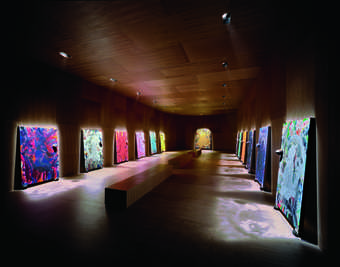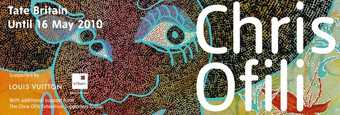Chris Ofili’s The Upper Room consists of thirteen paintings displayed in an environment especially designed by the architect David Adjaye. When it was first publicly exhibited in 2002, critics commented on the chapel-like qualities of the space and its lighting. The arrangement of twelve canvases flanking a thirteenth larger one suggests Christ and his Apostles, and the arrangement has an extraordinary sensory effect.
Each painting shows a rhesus macaque monkey, and each is dominated by a different colour, identified in Spanish on the elephant dung supports. In a text that accompanied the work’s first exhibition, a conservation biologist described the rhesus macaque as ‘loud, active, entertaining, fearsomely intelligent – the consummate cheeky monkey’. She also pointed out how rhesus monkeys have been venerated in certain religions, and observed that ‘monkeys may be godless but … rhesus macaques display a deeper degree of compassion for each other than do human beings’.
With this work Ofili raises questions about the relationships between civilisation and untamed nature, between the religious and the secular.



